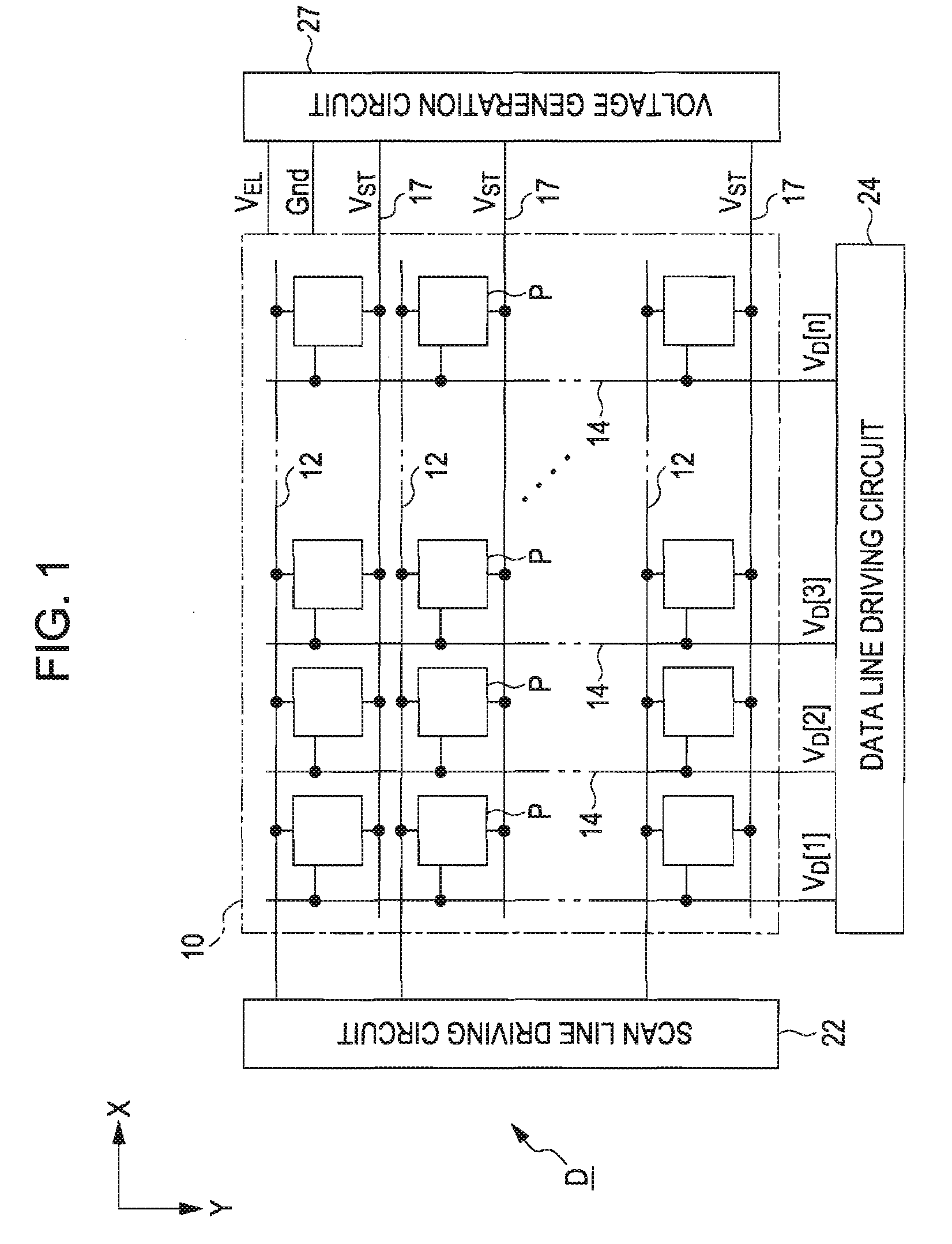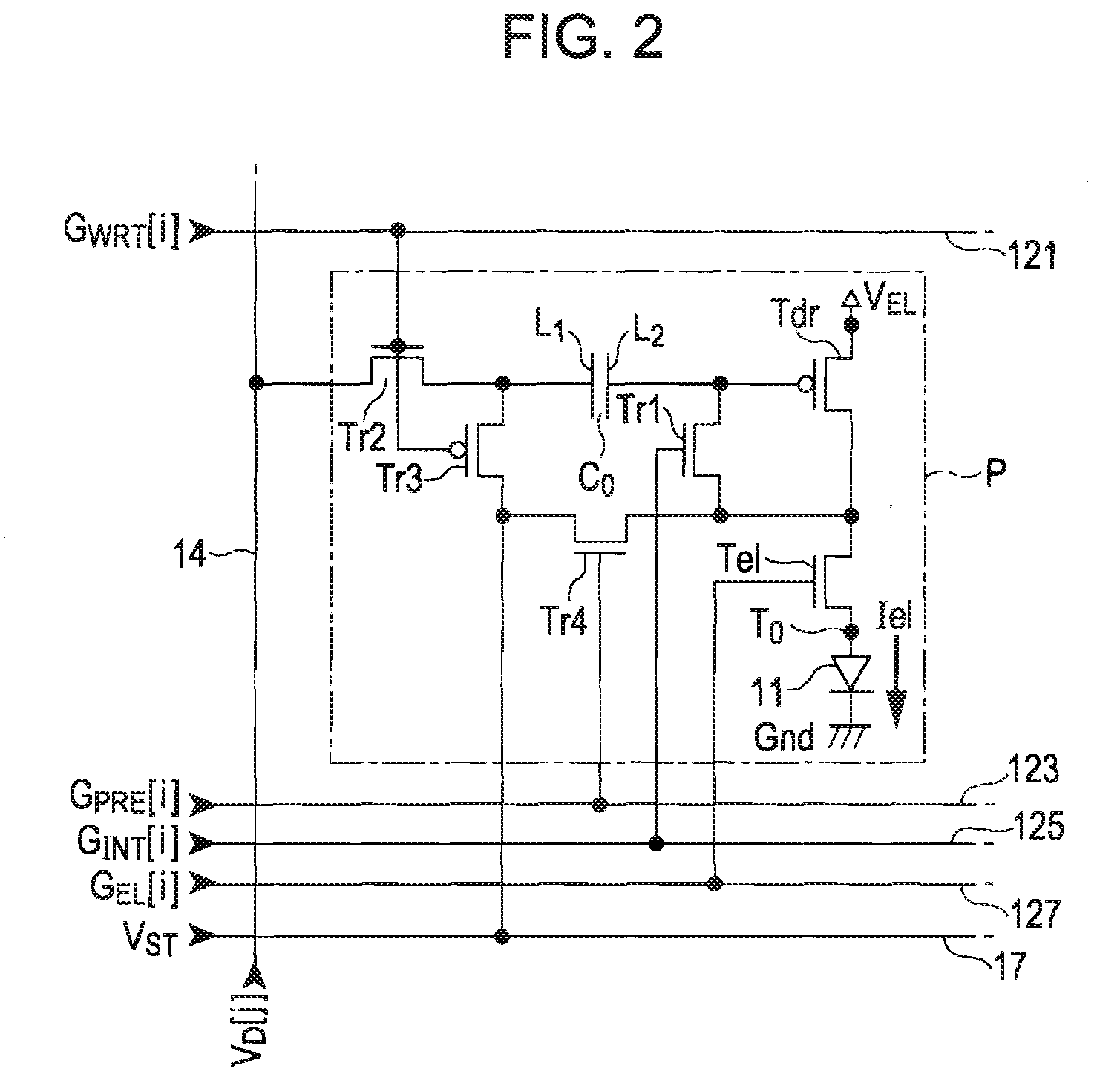Electric circuit, driving method thereof, electro-optical device, and electronic apparatus
a driving method and electric circuit technology, applied in static indicating devices, instruments, electroluminescent light sources, etc., can solve problems such as inability to achieve practical solutions, difficulty in reducing the size of pixel circuits, and inability to achieve uniform gray-scale level of light-emitting elements, etc., to achieve easy manufacturing and simplify the effect of wiring structur
- Summary
- Abstract
- Description
- Claims
- Application Information
AI Technical Summary
Benefits of technology
Problems solved by technology
Method used
Image
Examples
first modification
(1) First Modification
[0073]In the aforementioned embodiments, the transistors Tr2 and transistor Tr3 are counter conductive transistors to each other. However, the structure in which the transistor Tr2 and the transistor Tr3 operate in a complementary manner is not limited thereto. For example, as shown in FIG. 11, the transistors Tr2 and Tr3 may be provided as the same conductive-type transistors (n-channel transistors in this example). According to this example, a gate of the transistor Tr2 is connected to the first scan line 121a and a gate of the transistor Tr3 is connected to the second scan line 121b. The first scan line 121a is supplied with the first scan signal GWRTa(i) which is the same as the scan signal GWRT(i) shown in FIG. 4, and the second scan line 121b is supplied with the second signal GWRTb(i) which is logically reverse to the first scan signal GWRTa(i). The operation of this structure is also the same as that in FIGS. 5 to 8. Most of all, in the structure in whi...
second modification
(2) Second Modification
[0074]In this modification example, the transistor Tr4 and the light emission control transistor Tel shown in FIG. 2 are adequately omitted. FIG. 12 shows a circuit of a pixel circuit P in which the transistor Tr4 and the light emission control transistor Tel shown in FIG. 2 are omitted. In this structure, the scan signal GWRT(i) is the low level and thus the initialization signal GINT(i) is the high level during the initialization period PINT. Accordingly, as the transistor Tr3 is transited to the on-state, the potential of the gate of the drive transistor connected as a diode via the transistor Tr1 is converged to the potential VG(=VEL−Vth) corresponding to the threshold voltage of the gate of the drive transistor while the first electrode L1 is maintained at the potential VST.
[0075]During the subsequent period PWRT, the transistor Tr1 is turned off due to the low level of the initialization signal GINT(i). In addition, scan signal GWRT(i) is transited to th...
third modification
(3) Third Modification
[0077]The conductivity of the transistors constituting the pixel circuit P may be properly changed. For example, the drive transistor Tdr shown in FIG. 2 may be provided as an n-channel transistor. Even in this case, the potential VST of the electric supply line 17 is set to a level by which the drive transistor Tdr can be turned on when it is supplied to the gate of the drive transistor Tdr. IN addition, when the drive transistor Tdr is a n-channel transistor, the drive transistor Td1 is interposed between the gate of the drive transistor Tdr and the power source line (potential VEL). An OLED element is just an example of the electro-optical element 11. For example, instead of the OLED element, a variety of light-emitting elements such as an inorganic EL element or an LED (Light Emitting Diode) element may be used as the electro-optical element. In this embodiment, the electro-optical element is not limited in its structure. That is, the electro-optical elemen...
PUM
 Login to View More
Login to View More Abstract
Description
Claims
Application Information
 Login to View More
Login to View More - R&D
- Intellectual Property
- Life Sciences
- Materials
- Tech Scout
- Unparalleled Data Quality
- Higher Quality Content
- 60% Fewer Hallucinations
Browse by: Latest US Patents, China's latest patents, Technical Efficacy Thesaurus, Application Domain, Technology Topic, Popular Technical Reports.
© 2025 PatSnap. All rights reserved.Legal|Privacy policy|Modern Slavery Act Transparency Statement|Sitemap|About US| Contact US: help@patsnap.com



